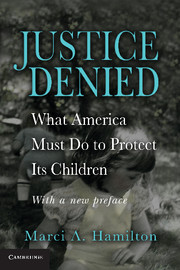Book contents
- Frontmatter
- Contents
- Acknowledgments
- 1 We Have Failed Our Children
- 2 What Is Wrong with the System? The Courthouse Doors Are Closed to Survivors
- 3 The Solution Is Clear and Simple: Abolish the Statutes of Limitation for Childhood Sexual Abuse
- 4 What It Will Take to Protect Children: What the States Must Do; What the Federal Government Should Do
- 5 Barrier #1: The Insurance Industry
- 6 Barrier #2: The Hierarchy of the Roman Catholic Church
- 7 The Other Barriers: Teachers, Defense Attorneys, and an Uninformed Public
- Conclusion: The Coming Civil Rights Movement for Children
- Appendix to Chapter 4
- Appendixes to Chapter 6
- Notes
- Index
6 - Barrier #2: The Hierarchy of the Roman Catholic Church
Published online by Cambridge University Press: 03 May 2010
- Frontmatter
- Contents
- Acknowledgments
- 1 We Have Failed Our Children
- 2 What Is Wrong with the System? The Courthouse Doors Are Closed to Survivors
- 3 The Solution Is Clear and Simple: Abolish the Statutes of Limitation for Childhood Sexual Abuse
- 4 What It Will Take to Protect Children: What the States Must Do; What the Federal Government Should Do
- 5 Barrier #1: The Insurance Industry
- 6 Barrier #2: The Hierarchy of the Roman Catholic Church
- 7 The Other Barriers: Teachers, Defense Attorneys, and an Uninformed Public
- Conclusion: The Coming Civil Rights Movement for Children
- Appendix to Chapter 4
- Appendixes to Chapter 6
- Notes
- Index
Summary
In 2002, a dark cloud arrived on our shared horizon with the first publication, by the Boston Globe, of the stories of hierarchical cover-up of clergy abuse within the Roman Catholic Church's Boston Archdiocese. The Globe, which won a Pulitzer Prize for its coverage, set into motion a mind-boggling series of revelations: The next reports involved the Diocese of Manchester, New Hampshire, and eventually the dioceses of a long list of cities (see Appendix A to Chapter 6).
For the Catholic hierarchy, though, the issue has remained solely an issue of “us against them.” Their focus has led them to fight reform that would benefit all survivors of child sex abuse, most of whom have had nothing to do with the Church.
The Experiences of the Roman Catholic Church Have Educated the Public on the Pervasiveness of Child Sex Abuse and the Failures of the Legal System
The Roman Catholic Church is the largest religious denomination in the United States, with 64 million members, or 22 percent of the U.S. population. Other than the federal government, it is difficult to imagine an institution in the United States that can match its presence, reach, or influence. By comparison, the largest U.S. corporation, measured by number of employees, is Wal-Mart Stores with 1.8 million. Even when compared at the international level, the church is huge. The Holy See is an independent sovereign, with 1.1 billion believers, constituting about one-sixth of the world's population.
- Type
- Chapter
- Information
- Justice DeniedWhat America Must Do to Protect its Children, pp. 67 - 96Publisher: Cambridge University PressPrint publication year: 2008



